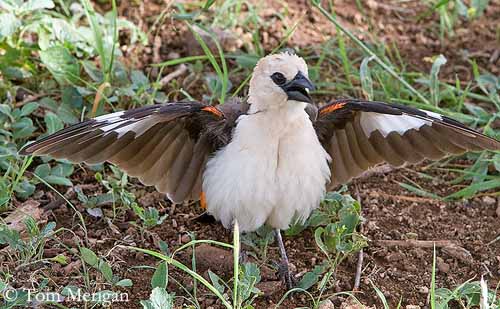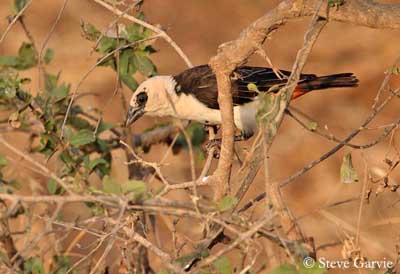
PROTECTION / THREATS / STATUS:
The White-headed Buffalo-Weaver is common in its range, mainly in arid areas with sparse habitations. There are several protected areas throughout the range where this species is common.
The White-headed Buffalo-Weaver is not currently threatened.
Fr: Alecto à tête blanche
All : Starweber
Esp: Tejedor Búfalo de Cabeza Blanca
Ital: Tessitore dei bufali testabianca
Nd: Witkop-buffelwever
Sd: Vithuvad buffelvävare
Photographers:
Fenerole Jean Michel
Photos d’Oiseaux
Garvie Steve
RAINBIRDER Photo galleries
Merigan Tom
Tom Merigan’s Photo Galleries
Text by Nicole Bouglouan
Sources:
HANDBOOK OF THE BIRDS OF THE WORLD Vol 15 by Josep del Hoyo-Andrew Elliot-David Christie - Lynx Edicions –
ISBN: 9788496553682
L’ENCYCLOPEDIE MONDIALE DES OISEAUX - Dr Christopher M. Perrins - BORDAS - ISBN: 2040185607
BIRDS OF AFRICA SOUTH OF THE SAHARA by Ian Sinclair and Peter Ryan - Princeton University Press Princeton and Oxford - ISBN: 0691118159
BirdLife International (BirdLife International)
White-headed Buffalo-Weaver
Dinemellia dinemelli
Passeriforme Order – Ploceidae Family
BIOMETRICS:
Length: 18 cm
Weight: 57-85 g
DESCRIPTION:
As other weavers, the White-headed Buffalo-Weaver builds a large elaborated nest. This bird is often seen in small groups feeding on the ground or perched in trees. It also follows the African Buffalo, taking advantage of the disturbed insects. Its name comes from this habit.

Both sexes are similar. They are bulky birds.
The adult of nominate race is mainly white except on the upperparts.
The head, throat and underparts are white, except the orange-red undertail-coverts and the dark brown thighs. The bare lores and the narrow eye-ring are black.
On the upperparts, mantle and back are dark brown. The rump and the uppertail-coverts are orange-red.
The upperwing is dark brown with blacker primary flight feathers. We can see a narrow white edge on the outer webs of the greater coverts and on secondary and tertial flight feathers. A white band is visible at the primaries’ base.
The tail is dark brown with narrow white margin on the outer webs of the outermost pair of rectrices. We can see a narrow white fringe at tail tip.

The strong, conical bill is black, but it may change seasonally. During the breeding season, it is often paler, almost whitish. The eyes are dark brown. Legs and feet are dark grey.
The juvenile has pale orange tail-coverts, and a conspicuous gape wattle.
We can find two subspecies:
D.d. dinemelli occurs in the northern parts of the range.
D.d. boehmi is found in the southern parts.
This one has mainly black upperparts, wings and tail, with reduced white edges.
VOICE: SOUNDS BY XENO-CANTO
The White-headed Buffalo-Weaver gives parrot-like strident calls “skwieeer” or “kiiyerr”. It also utters a ringing “tew” regularly repeated.
Variable sounds as chuckles and whistles can be heard at breeding and roosting sites.
The song is slow and drawn out. The phrases include piercing nasal calls and trills “tsu-weely-weely-wair”.

HABITAT:
The White-headed Buffalo-Weaver frequents semi-arid habitats such as dry bush and thorny savannah, usually below 1400 metres of elevation.
This species is rarely found in grassland. However, it frequents the Acacia’s thickets.
RANGE:
The White-headed Buffalo-Weaver is common throughout East Africa, from Ethiopia and Sudan to Kenya and Tanzania.
BEHAVIOUR:
The White-headed Buffalo-Weaver feeds primarily on insects such as Coleopteran and Lepidoptera. It also takes fruits and seeds.
It forages in groups of 3-6 birds, and often with other species such as Sturnidae. In Somalia, it is often associated with the Superb Starling and other similar species. In Kenya, it is found in open woodlands in mixed-species flocks.
It forages on or near the ground in thorny bushes. Its strong bill allows it to crack open the hard seeds.

They feed in acrobatic way and can hang upside-down, almost similar to the parrots. When they climb among foliage and branches in trees, they are very noisy.
The White-headed Buffalo-Weaver is territorial and can be aggressive towards the intruders, but the encounters are mainly vocal. Usually, they are gregarious and feed, breed and roost together.
During the breeding season, they perform courtship displays. They prefer to display in open branches in trees, but also sometimes on the ground. The male spreads its wings in front of the female to display the white wing-patches and the red-orange tail-coverts.

They are monogamous and both mates build the nest together. The male sings alone at tree top and around the nest.
The White-headed Buffalo-Weaver is apparently resident with probably local movements and dispersions according to the food resources.
FLIGHT:
Any available information.
REPRODUCTION:
The breeding season depends on rainfall and varies according to the range.
Both sexes build the nest. They use rigid nest-materials pushed together but not interweaved as in most weavers’ species.
The construction starts by laying materials on or across a horizontal branch. The structure is oval and about 50 centimetres long. The birds build first the inner grassy structure, a dome made with dry grass stems and lined with softer materials such as grass, leaves and feathers.
Then, they add thorny sticks and twigs outside, forming a kind of “shell”, a good protection against the predators. And finally, a short entrance tube opens downwards.
The nest is placed 2-4 metres above the ground and can be on a branch, or suspended from end or underside of the branch. The same tree may contain several nests which belong to the same pair. They can be used by other species such as the African Pygmy-falcon and some passerines.

The female lays 3-4 greyish to pale blue eggs with brown and olive markings. The incubation lasts 11-14 days. The chicks are fed by both parents with insects and small seeds. They fledge about three weeks after hatching.
This species can breed solitary or in colonies. Some observations made in captivity of 3 adults feeding a young may suggest occasional co-operative breeding
Snakes and birds of prey are the main predators of the weavers.
DIET:
The White-headed Buffalo-Weaver feeds on insects, seeds and fruits. The strong bill allows it to crack open the hard seeds. It catches insects, beetles and caterpillars.
It forages often in small groups, but outside the breeding season, it can be seen in mixed-species flocks. It forages mainly on the ground.
